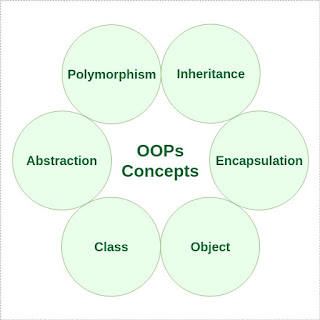OOPs in Java
Object Oriented Programming (OOPs)
Object-oriented
programming: As
the name suggests, Object-Oriented Programming or OOPs refers to languages that
uses objects in programming. Object-oriented programming aims to implement
real-world entities like inheritance, hiding, polymorphism etc in programming.
The main aim of OOP is to bind together the data and the functions that operate
on them so that no other part of the code can access this data except that
function.
OOPs Concepts:
·
Class
·
Object
·
Method
·
Message
Passing
the different characteristics of an
Object-Oriented Programming language:
1. Polymorphism: Polymorphism refers to the ability of
OOPs programming languages to differentiate between entities with the same name
efficiently. This is done by Java with the help of the signature and
declaration of these entities.
For example:
|
//
Java program to demonstrate Polymorphism
//
This class will contain
//
3 methods with same name,
//
yet the program will
//
compile & run successfully
public
class Sum {
//
Overloaded sum().
//
This sum takes two int parameters
public
int sum(int x, int y)
{
return
(x + y);
}
//
Overloaded sum().
//
This sum takes three int parameters
public
int sum(int x, int y, int z)
{
return
(x + y + z);
}
//
Overloaded sum().
//
This sum takes two double parameters
public
double sum(double x, double y)
{
return
(x + y);
}
//
Driver code
public
static void main(String args[])
{
Sum
s = new Sum();
System.out.println(s.sum(10,
20));
System.out.println(s.sum(10,
20, 30));
System.out.println(s.sum(10.5,
20.5));
}
}
|
Output:
30
60
31.0
1.
Polymorphism
in Java are mainly of 2 types:
2. Inheritance: Inheritance is an important pillar of
OOP(Object Oriented Programming). It is the mechanism in java by which one
class is allow to inherit the features(fields and methods) of another class.
Important terminology:
·
Super Class: The class whose features are inherited is
known as superclass(or a base class or a parent class).
·
Sub Class: The class that inherits the other class
is known as subclass(or a derived class, extended class, or child class). The
subclass can add its own fields and methods in addition to the superclass
fields and methods.
·
Reusability: Inheritance supports the concept of
“reusability”, i.e. when we want to create a new class and there is already a
class that includes some of the code that we want, we can derive our new class
from the existing class. By doing this, we are reusing the fields and methods
of the existing class.
The keyword used for inheritance is extends.
Syntax:
class derived-class extends
base-class
{
//methods and fields
}
3. Encapsulation: Encapsulation
is defined as the wrapping up of data under a single unit. It is the mechanism
that binds together code and the data it manipulates. Another way to think
about encapsulation is, it is a protective shield that prevents the data from
being accessed by the code outside this shield.
·
Technically
in encapsulation, the variables or data of a class is hidden from any other
class and can be accessed only through any member function of own class in
which they are declared.
·
As
in encapsulation, the data in a class is hidden from other classes, so it is
also known as data-hiding.
·
Encapsulation
can be achieved by Declaring all the variables in the class as private and
writing public methods in the class to set and get the values of variables.

encasulation in java

1. Abstraction: Data
Abstraction is the property by virtue of which only the essential details are
displayed to the user.The trivial or the non-essentials units are not displayed
to the user. Ex: A car is viewed as a car rather than its individual components.
Data Abstraction may also be defined as the
process of identifying only the required characteristics of an object ignoring
the irrelevant details. The properties and behaviours of an object
differentiate it from other objects of similar type and also help in
classifying/grouping the objects.
Consider a real-life example of a man driving
a car. The man only knows that pressing the accelerators will increase the
speed of car or applying brakes will stop the car but he does not know about
how on pressing the accelerator the speed is actually increasing, he does not
know about the inner mechanism of the car or the implementation of accelerator,
brakes etc in the car. This is what abstraction is.
In java, abstraction is
achieved by interfaces and abstract classes. We can achieve 100% abstraction using
interfaces.
2.
Class: A class is a user defined blueprint or
prototype from which objects are created. It represents the set of properties
or methods that are common to all objects of one type. In general, class
declarations can include these components, in order:
·
Class name: The name should begin with a initial
letter (capitalized by convention).
·
Superclass(if any): The name of the class’s parent
(superclass), if any, preceded by the keyword extends. A class can only extend
(subclass) one parent.
·
Interfaces(if any): A comma-separated list of interfaces
implemented by the class, if any, preceded by the keyword implements. A class
can implement more than one interface.
·
Body: The class body surrounded by braces, { }.
3.
Object: It is a basic unit of Object Oriented
Programming and represents the real life entities. A typical Java program
creates many objects, which as you know, interact by invoking methods. An
object consists of:
·
State : It is represented by attributes of an
object. It also reflects the properties of an object.
·
Behavior : It is represented by methods of an object.
It also reflects the response of an object with other objects.
·
Identity : It gives a unique name to an object and
enables one object to interact with other objects.
Example of an object: dog

oops in java








No comments:
Post a Comment